Kirby Air Riders review for Nintendo Switch 2
System: Switch 2
Release date: November 20, 2025
Developer: Bandai Namco / Sora
Publisher: Nintendo
Kirby is a versatile little fellow – outside of his core 2D (and as of late, 3D) platforming adventures, Nintendo’s most rotund character has starred in a battle royale, puzzle games, fighters, and more. His big 2003 debut into the racing genre, Kirby Air Ride, now receives a sequel over twenty years later that feels more like an expanded remake at times, revisiting the original concept but expanding and improving upon it at seemingly every turn. It’s also wholly unlike most other racing games, and its diversity of game modes, breakneck pace and Super Smash Bros-esque flair make it feel more like a party game at times. While not all the pieces of Kirby Air Riders are equally compelling, and I’m not sure the game will have the staying power for me personally that I had hoped, I was certainly never bored while playing—and often, the adrenaline from the game’s more intense moments had me on the edge of my seat.
Kirby Air Riders offers a wide slate of modes for players to dive into, but at its core, this is a game about picking a rider and a machine and zipping around Planet Popstar at breakneck speeds. Much of the fun for me came primarily from exploring how different machines worked, how controlling them felt with different riders, and discovering how best to leverage the unique abilities each combination enables. I can’t say I’ve ever played a vehicle-based game before where swapping to a different machine completely changes how one might play. Normally in racing games, once I’ve found a setup I like I tend to stick with it, but in Air Riders I usually randomized it, simply because the variety is such a blast.
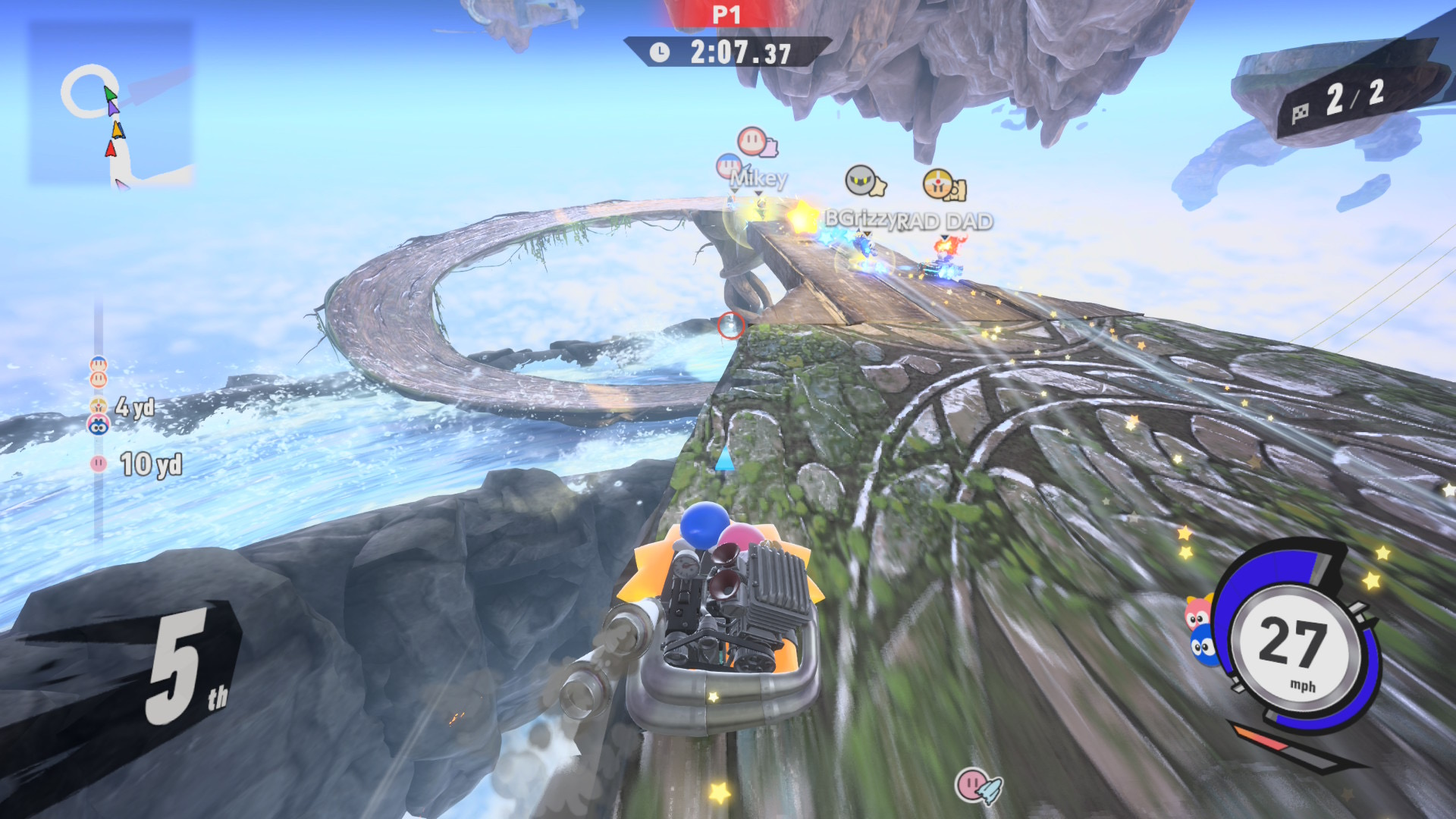
For example, in Air Ride – the game’s main racing-focused mode – most of the game’s 18 courses have various points where the track splits. When I was controlling a vehicle like the Jet Star, it was in my interest to seek out ramps and places where I could catch some air, as I’d be rewarded with a massive speed boost by doing so. On the other hand, when controlling something like the Swerve Star – a vehicle that needs to come to an outright stop to set up for a turn before blasting off in the set direction – I found myself opting for paths that with fewer steep corners to navigate around.
Kirby Air Riders is also different than other racing games in that you don’t need to manually accelerate. Instead, increasing your top speed in a race comes from not only how well you play to the strengths of your setup, but also how you engage with the game’s other systems. Riders can spin attack into enemies, resulting in a speed boost, and they can also copy their abilities once in range. These abilities generally make your racer faster when utilized successfully, whether that’s by slashing into foes with a sword (gaining momentum after each hit) or drilling underground before launching into the air. Speed is also gained by using the Boost ability, which actually involves slowing down your rider (sometimes to a complete stop) in order to charge up and launch off along the track. This is also how the game lets players drift around tight curves. Players can also slipstream behind enemies for an additional speed boost.
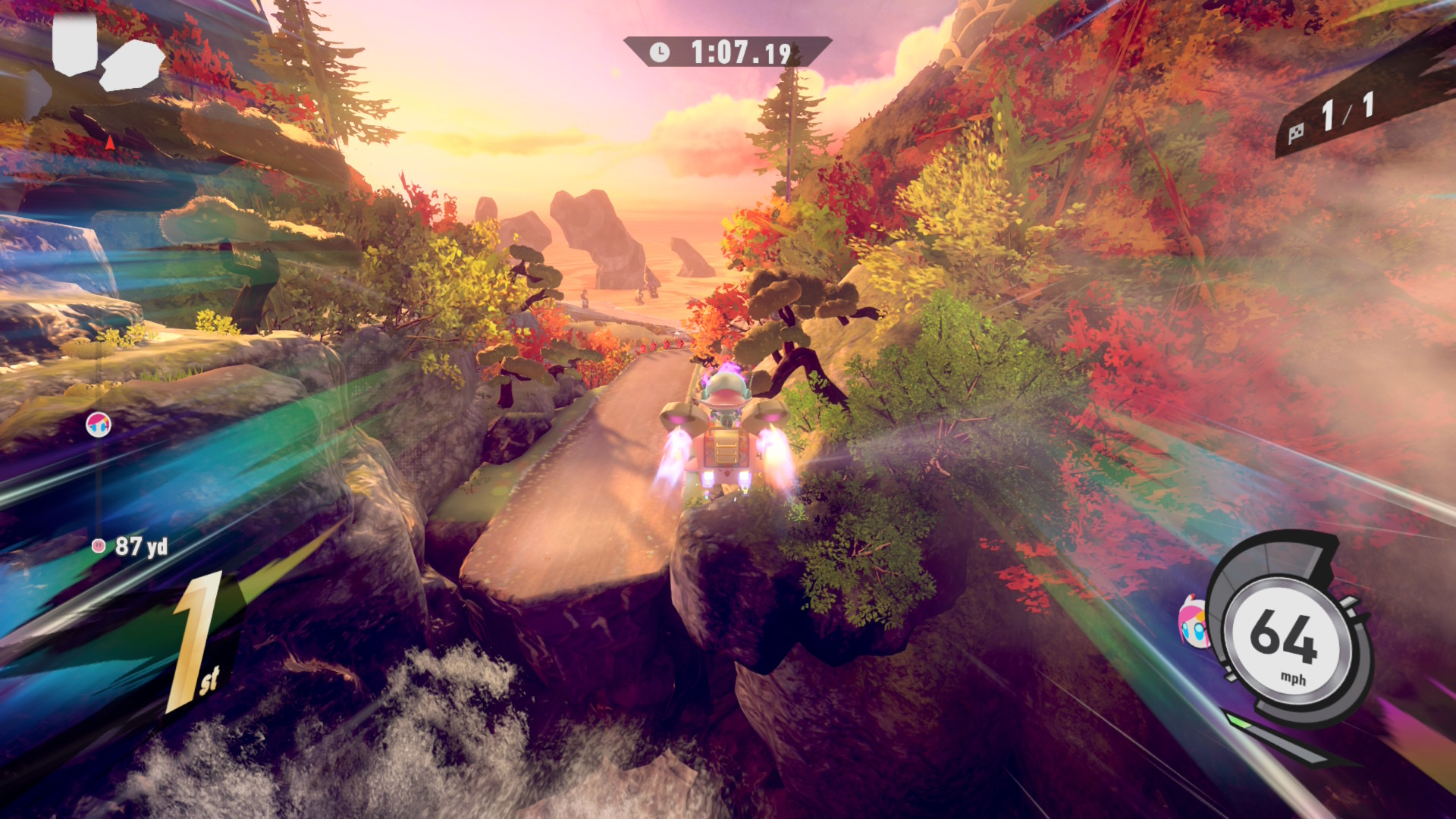
When you combine this focus on offensive play with the tightly designed tracks that often seem to defy the laws of physics, what you have is a racing experience that feels blisteringly fast and downright chaotic at times. The game’s 18 courses – 9 brand new, and 9 reimagined from the original game – are all a feast for the senses, a true visual spectacle to behold. One of my favorites is Waveflow Waters, in which a good chunk of the course takes place between the parted tides of the ocean. Another highlight was Cyberion Highway, which feels like a futuristic take on Mario Kart’s Rainbow Road if there were a high-tech flair to the whole affair. Not all courses (and characters) are unlocked from the start, but most of them become playable pretty quickly once you spend some time with the game.
At first, there is a satisfying learning curve that comes with gaining familiarity with each course. Over time, that familiarity had me wishing there were just a few more areas to race through. What’s here is truly excellent, and if one wants to make an argument of “quality over quantity” than Kirby Air Riders is a great case study. But once the visual spectacle of some of the tracks’ more exciting set pieces begins to set in, the reward from continued play mostly lies in improving lap times and battling harder CPUs, or hopping online. That’s fun to a degree, but not the kind of thing that’s going to suck me in for hours at a time.
To this game’s credit, there is a crap ton of stuff to unlock by completing in-game challenges. Across all of Kirby Air Riders’ modes, there are hundreds of achievements to check off, from racing a certain number of times on a specific course to more obscure tasks, like not collecting any copy abilities during a race. Most of these achievements, I’ve found, can be unlocked passively just by playing by the game, but it’s also possible to pick one you haven’t completed yet and immediately set up a match with the conditions required to knock it out. Completing all the achievements unlocks gallery images (exciting!), but completing individual ones unlocks a massive swath of cosmetic items to do things like customizing your license and machine. For me personally, I don’t find that very compelling, so once I had unlocked all riders and machines I mostly stopped caring about this.
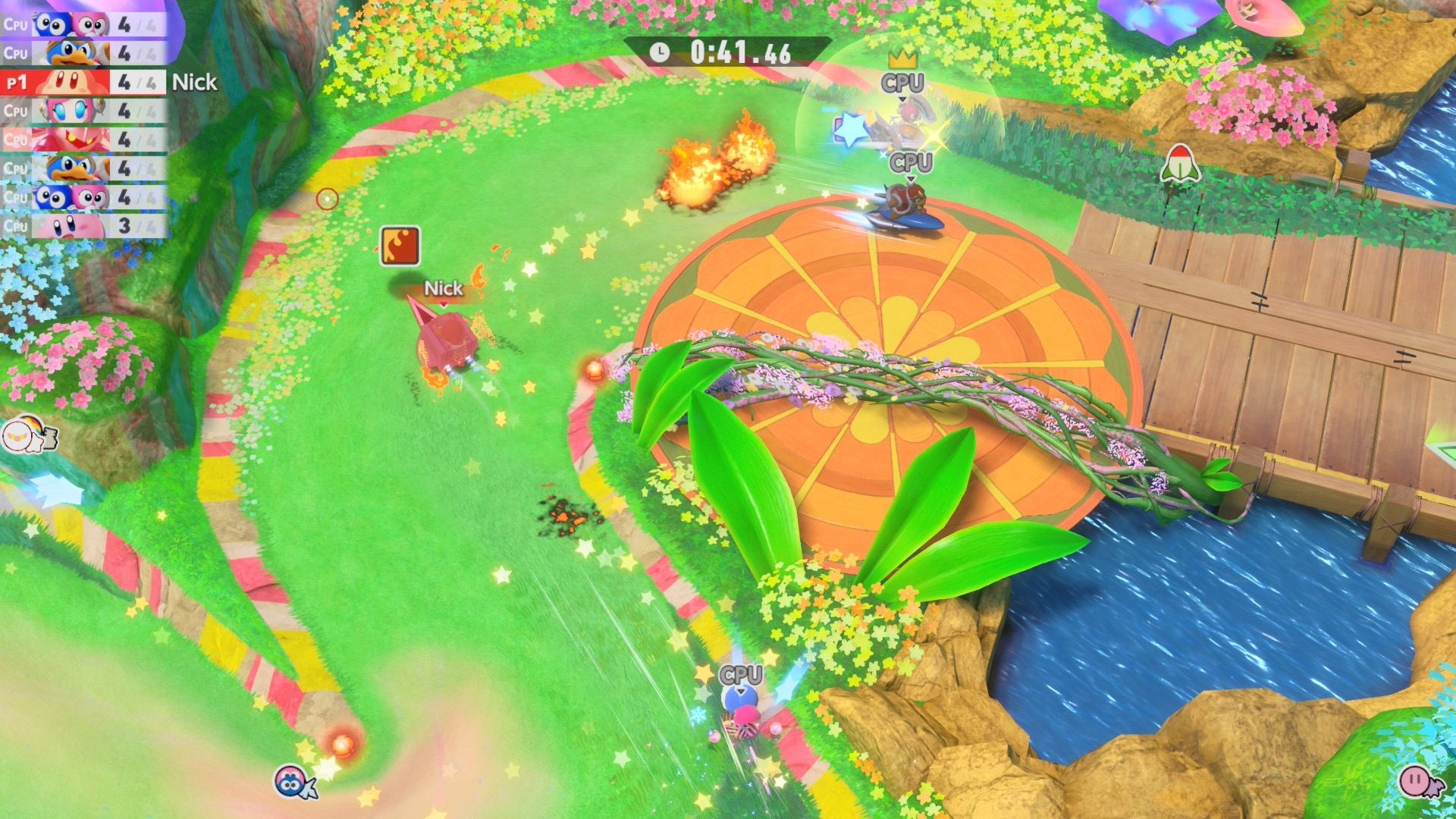
Beyond Air Ride mode, there’s also Top Ride, which is essentially the same thing reformatted for top-down, bite-sized races. It’s simple, arcade-style fun, and exciting in short bursts, but not the kind of thing I would really want to compete in against others, be that online or locally (although both options exist).
The game mode that has perhaps generated the most public excitement in Kirby Air Riders is City Trial, which returns from the original game bigger and better than ever. City Trial matches takes place in two phases: in the first phase, players are dropped into a small but dense arena-style map called Skyah for five to seven minutes. The goal here is to find your preferred vehicle and smash crates, defeat enemies and explore to try and power it up and improve its stats. Often, dynamic events will occur that will change up the map in the middle of a session, or introduce additional objectives to complete for bigger rewards. After that, players will select a stadium minigame to compete in, which can range from a drag race across a track filled with grind rails to a game of life-sized darts (where you and your machine are the dart).
I had fun with City Trial mode in short bursts. The first phase, in which everyone is zipping around Skyah for a few minutes, is a great time! The map is well-designed, with tons of secret areas to uncover, and traversing around it – whether by ground or by air or by grind rail – is a blast. Nothing makes the dopamine receptors fire off like breaking stuff and watching my racer suck up colorful powerups to get faster and more nimble. It’s fun competing against others and trying to destroy their machines, and I love the concept of what’s essentially a bite-sized battle royale mode.
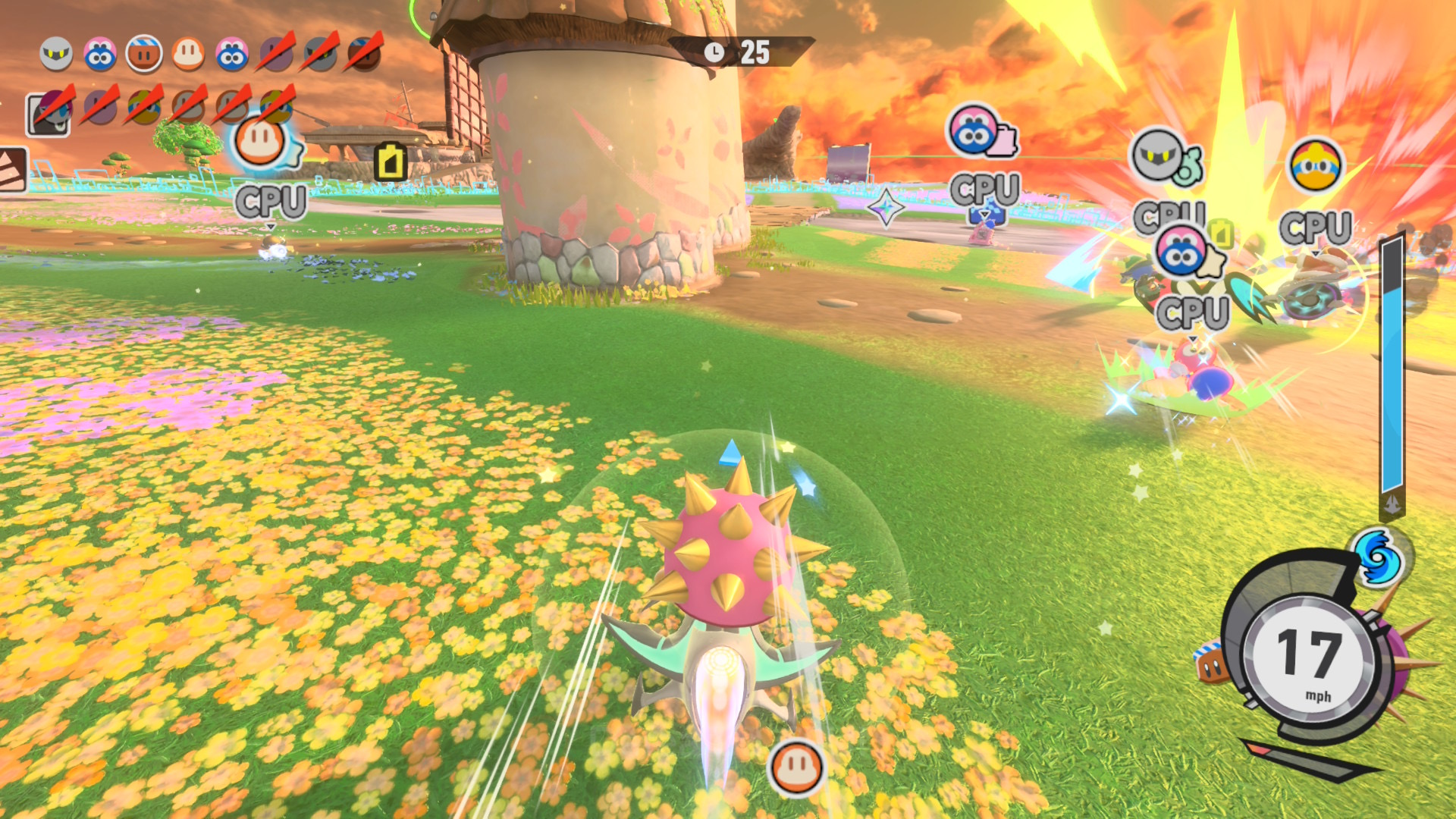
Over time though, I realized that there’s not nearly as much depth to this mode as the game would like you to think there is. As long as you manage to obtain a versatile enough machine at the outset, it really matters very little how exactly you power up your ride as long as the sheer quantity of stuff you pick up is high. Because at the end of the day, you spend all this time to ultimately compete in a single, flash-in-the-pan minigame, of which most are finished in under two minutes, and sometimes less.
The hook with City Trial is that if you don’t do a good enough job during the first phase of building your ideal machine, that you might be at a disadvantage in the Stadium event portion that follows. This can be true in very limited circumstances. For example, some vehicles can’t glide at all, and in some events you need to be able to do that. But beyond that, because all vehicles are so well balanced, and because the single minigame you compete in is so short, it all just feels a bit like the juice ain’t worth the squeeze, so to speak. It might have helped if there were more city trial maps to compete on, or fewer powerups to collect while racing across Skyah, or maybe having players complete in 2-3 stadium events during the second phase rather than just one. But as things are, by default the stakes just don’t feel all that significant.
When you take together that City Trial, Top Ride, and Air Ride mode can all be played solo, locally, or via online multiplayer, it does make for a pretty robust package, and it’s all fun in its own way. I have to give the game credit that I had zero performance issues at any point, whether playing in splitscreen or online, which is really impressive considering just how much is happening onscreen at any given time, and that’s to say nothing of the environmental effects and visual detail. Technically, this game is a great showcase for Nintendo Switch 2, and if you’re looking for something to boot up for quick matches against friends or strangers online, I think this will be a very satisfying package. For me personally, I have little interest in climbing the leaderboards – I’m more invested in mastering in the mechanics of the game itself and just trying to have a good time – so there wasn’t a huge practical difference for me in how much fun I had playing online versus playing against CPU players. I suppose that’s a compliment!

Since I am primarily a solo player, though, it was the game’s final core mode, Road Trip, that really piqued my interest. This is Air Riders’ main single player mode, and it’s such a good time that I think it will be what keeps me coming back to this game the most. In Road Trip, you pick your character and progress through eleven stages. You start with a machine that moves painfully slowly, and over time, you complete progressively more difficult challenges to improve your ride’s performance. As you move automatically through a biome, you’ll be able to choose between one of three challenges at a time to compete in, with different rewards depending on which one you take on. The whole thing is tied together with a light, but satisfyingly schlocky cutscene-driven story in the vein of Super Smash Bros. Brawl’s Subspace Emissary mode, which makes the nostalgic part of my brain happy (even if it’s not the most interesting story in the world).
The reason Road Trip mode works is because it takes everything from the rest of the game and mashes it altogether in a delectable smorgasbord of challenges. You’ll do Air Ride races, Top Ride races, and Stadium events, but the cool part is that there are unique twists on these modes that are only present in Road Trip. For example, you might be racing along an Air Ride course, but instead of needing to just finish in first place, you might be tasked with knocking out all the racers on the track before the time is up, or KO’ing the first place racer before they can cross the finish line. Or you might be dropped into Skyah, but instead of a City Trial battle you’re facing a timed boss fight against an iconic foe from Kirby’s past.
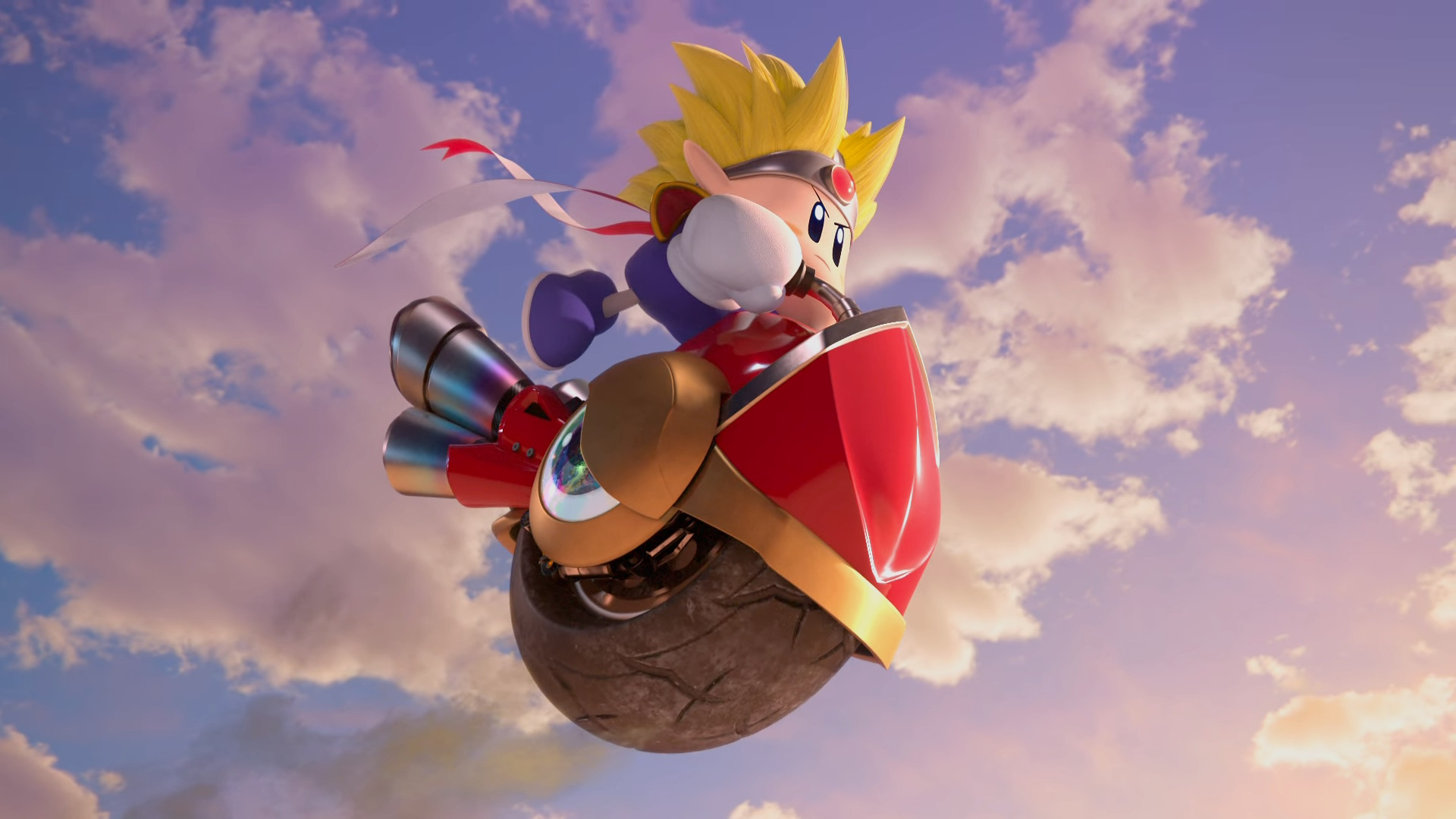
Not only is the variety insane, but the best part is that players can choose between one of three options in most cases, so you’re rarely forced into competing in challenges you’re not interested in. Alternatively, you can opt to take on harder challenges for higher rewards in certain cases. There are multiple branching paths, meaning its not possible to see each biome in a single playthrough, and Road Trip mode even offers a New Game+ mode that unlocks an additional cutscene at the end. Because it only takes 2-3 hours to fully run through Road Trip Mode, it’s the perfect way to get a taste of everything Kirby Air Riders has to offer. Its replayable, varied and just downright fun.
Finally, I have to highlight that if you’re a Kirby fan, this game essentially feels like a massive celebration of the franchise in ways that no other Kirby game is. From the stellar soundtrack that brings back classic tunes and remixes others, to a wide slate of playable characters who are all lovingly crafted and animated, to the little surprises that pop up along the way, this game just warmed my heart. Even though I had gripes with how some of the game modes played out, the reality is that I was always having fun, and there is an insane amount of customization and options available to let players have the experience they want. While I’m not going to be binging this game for dozens of hours a time, Kirby Air Riders will absolutely have a permanent place on my Switch 2 for those occasions when I want some of the most cathartic racing action that I can get on a Nintendo console.
There’s no other game quite like Kirby Air Riders out there (other than the 2003 original) so if the idea of blazing fast, spectacular races and chaotic, bite-sized challenges against friends and CPUs sounds like fun, you’re unlikely to be disappointed here. While it’s an immensely polished and fleshed-out game, not all of its core game modes maintained my interest as much as I had hoped, and a few more maps in Air Ride mode and City Trial would have helped round out what’s here. Unless you really like checking off achievements and unlocking decorative items, you may find yourself wishing for just a little more meat to chew on when it comes to progression. But Kirby Air Riders certainly has something for everyone, and as a pick up and play experience – something to dip into between bigger games, perhaps – if this style of vehicular action resonates with you, you’ll almost certainly have a great time.
Kirby Air Riders copy provided by the publisher for the purposes of this review.

